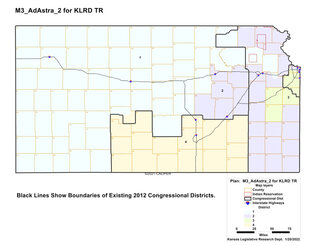Kansas Supreme Court upholds Republican congressional map
4 min read
FILE - This image shows the "Ad Astra 2" congressional redistricting plan for Kansas drafted by the Kansas Legislative Research Department for Republican leaders in the GOP-controlled Legislature, Tuesday, Jan. 25, 2022, at the Statehouse in Topeka, Kan. A Kansas district court judge on Monday, April 25, 2022, struck down a new Republican-backed congressional map that would likely make it harder for the only Democrat in the state's delegation to win reelection this year. (Kansas Legislative Research Department via AP)
TOPEKA, Kan. (AP) — Kansas’ highest court on Wednesday upheld a Republican redistricting law that makes it harder for the only Democrat in the state’s congressional delegation to win reelection in a big victory for the GOP.
The state Supreme Court declined for now to declare that overly partisan gerrymandering violates the Kansas Constitution. The ruling sets district boundaries less than a month before the state’s June 10 filing deadline for congressional candidates.
The court’s opinion was two paragraphs long, saying only that the voters and voting rights group challenging the map “have not prevailed on their claims” that the map violated the state constitution and that a full opinion would come later.
The brief decision was written by Justice Caleb Stegall, who is seen as the most conservative of the court’s seven justices, five of whom were appointed by Democratic governors. During arguments from attorneys on Monday, he questioned whether anyone could clearly define improper partisan gerrymandering.
Lawsuits over new congressional district lines have proliferated across the U.S., with Republicans looking to recapture a U.S. House majority in this year’s midterm elections. Congressional maps in at least 17 states have inspired lawsuits, according to the nonpartisan Brennan Center for Justice.
In the past, congressional district lines have been reviewed by federal judges and not the state Supreme Court. The conservative-leaning U.S. Supreme Court ruled in a 5-4 decision in 2019 that complaints about partisan gerrymandering are political issues and not for the federal courts to resolve.
The state’s Republican-appointed solicitor general argued in defending the GOP-drawn map that because the state constitution doesn’t specifically mention gerrymandering or congressional redistricting, the Kansas Supreme Court should reject the legal challenges. He and other state officials said that the justices had no guidance on how to define improper political gerrymandering.
Kansas Attorney General Derek Schmidt, a Republican running for governor, hailed the ruling as a victory for “the public’s right to establish new districts through their elected representatives.”
Democrats argued that the map was drawn to help Republicans unseat Democratic U.S. Rep. Sharice Davids in the 3rd District, in the Kansas City area, and that it diluted the political clout of Black and Latino voters. Twenty voters and a voting rights group, Loud Light, filed three lawsuits that were consolidated into one, and a lower court sided with them.
State Senate Minority Leader Dinah Sykes, a Kansas City-area Democrat, said Republicans had “disrespected, ignored and gaslit engaged voters from the very start.”
And House Minority Leader Tom Sawyer, a Wichita Democrat, added: “The decision regarding Congressional maps opens a Pandora’s box for even worse political gerrymandering in the future.”
State courts have issued decisions favoring Democrats in Florida, North Carolina, Ohio and Pennsylvania. New York’s highest court recently declared that that state’s new districts were gerrymandered to favor Democrats.
The Kansas lawsuits argued that the state’s bill of rights prohibits partisan gerrymandering by declaring that “free governments” are formed for the people’s “equal protection and benefits” and that the state’s residents have “equal and inalienable natural rights” including, “life, liberty, and the pursuit of happiness.” The state Supreme Court also cited that latter provision in 2019 in declaring access to abortion a “fundamental” right in Kansas.
Republican legislative leaders argued that based on 2020 election results, Davids still could win her new district. They said their map was a fair way to rebalance the population in each of the state’s congressional districts to make them as equal as possible after 10 years of demographic shifts.
The map moved the northern part of Kansas City, Kansas, out of the 3rd District represented by Davids and into the larger 2nd District of eastern Kansas represented by Republican Rep. Jake LaTurner. Kansas City, Kansas, is among the few Democratic strongholds in the GOP-leaning state. Davids lost territory where she performs well, while the new map added several rural, heavily Republican counties to her district.
The map also moved the liberal northeastern Kansas city of Lawrence — a Democratic stronghold that is home to the main University of Kansas campus and is only about 40 miles (64 kilometers) west of Kansas City — out of the 2nd District. Instead, the city of 95,000 has been added to the already sprawling 1st District, which is dominated by small conservative communities in central and western Kansas.
The lower court’s ruling relied heavily on the testimony of a University of Michigan political scientist who used a computer algorithm to produce 1,000 alternative redistricting plans to conclude that the new districts “are extreme pro-Republican partisan outliers.”
In a separate ruling, the state Supreme Court also upheld maps drawn by Republicans for legislative districts that are expected to preserve the GOP’s supermajorities in both chambers.







